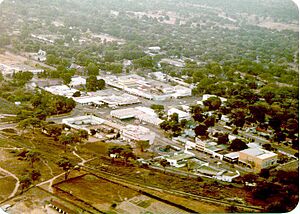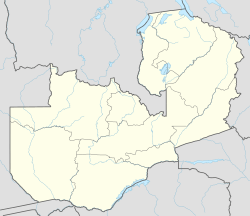Luanshya facts for kids
Quick facts for kids
Luanshya
|
||
|---|---|---|
|
Town
|
||
 |
||
|
||
| Nickname(s):
wall fence town
|
||
| Country | ||
| Province | Copperbelt Province | |
| District | Luanshya District | |
| Government | ||
| • Type | municipal government | |
| Area | ||
| • Urban | 1,007.6087 km2 (389 sq mi) | |
| Elevation | 1,225 m (4,019 ft) | |
| Population
(2020)
|
||
| • Town | 154,863 | |
| Time zone | UTC+2 (CAT) | |
| Area code(s) | (+260) 2 | |
| Climate | Cwa | |
Luanshya is a town in Zambia, located in the Copperbelt Province near Ndola. In 2008, about 117,579 people lived there. The town is in an area that traditionally belonged to Chief Mushili of the Lamba people.
Luanshya was founded in the early 1900s. A prospector named William Collier discovered a large amount of copper ore. He found it after shooting a Roan Antelope near the Luanshya River. The antelope fell with its head on a rock, showing the copper. The mining company formed to dig up this copper was called "Roan Antelope Copper Mines Ltd."
For most of the 20th century, a lot of copper was mined in Luanshya. However, later in the century, mining became less profitable. This caused a difficult time for the town. There is still a good amount of copper underground. The town's future depends on how well this copper can be mined and sold.
Luanshya is the birthplace of famous people like folk singer John Edmond, writer A. C. Grayling, and former Vice President of Zambia, George Kunda.
The Roan Antelope Rugby Club in Luanshya once had the tallest goal posts in the world. They were 110 feet, 6 inches high! This was even recognized by the Guinness Book of Records.
Contents
The Story Behind the Name
A popular story says that in the early days of the Roan Antelope Mine, there was a river snake causing problems. Workers faced many illnesses like malaria and other fevers. They also had issues with floods and cave-ins in the mines. Local people believed a giant snake was responsible for these problems.
By 1928, construction of the mine and town began. The flooding problem was solved when the Luanshya River was redirected and its swampy areas were drained. This happened during a campaign to fight malaria between 1929 and 1932.
Some people mistakenly thought the town's early health problems earned it the nickname "Valley of Death." However, the name Luanshya actually means "river of antelopes." Many antelopes used to live in the area before mining settlements grew. Places like the Luanshya River, Luanshya Stream, and Luanshya Town are all named after these animals. The town's name likely came from the Luanshia mining claim. Three mining claims were named after antelopes: Rietbok, Roan Antelope, and Luanshia.
To understand the name better, imagine a time when a river and stream got their name from the antelopes that drank there. Then, people came, found copper, and started mining. They also used animal names for their mines, like "roan" (mpelembe) and "nsha" (duiker). They became very successful from the mine.
Education in Luanshya
Luanshya is home to a Technical and Vocational Teacher's College (TVTC). Many teachers for technical subjects in Zambia have graduated from this college. The town also has Luanshya Technical and Business College (LTBC), which offers technical courses for college students. These two colleges are very close to each other.
Across the road from them is Da Gama school. This is one of the few schools in the Copperbelt Province for students with disabilities. Nuns manage the school, and it is named after the famous explorer Vasco da Gama.
Before Zambia became independent, schools were separated by race. There were different schools for Europeans, Asians, and Africans. For white students, there was Luanshya Primary School (now called Central) and Luanshya High School. Asoka Primary School (later named Gandhi) was for Asian students. For African students, there were schools like Arusha Primary School in Mikomfwa, Mwaiseni in Mpatamatu, and Fisansa in Roan townships.
After independence, many more schools were built. In Mikomfwa, new schools included Ndelela, East School (now Twatemwa), West School (now Muchinshi), and Mipundu. Arusha was later renamed Bwananyina. In Roan Township, there were Roan, Chaisa, Makoma, and Kafubu primary schools. Mpatamatu had Mpatamatu, Nkulumashiba, and Nkambo primary schools. Luanshya township had Rivercross, Harrison (now Mpelembe), and Convent (now Buteko).
For secondary schools, Mikomfwa township did not have one. Luanshya township had Luanshya High School for boys and Luanshya Girls High School. Roan township had Roan Antelope Secondary, and Mpatamatu township had Mpatamatu Secondary.
Economic Activities
During a time when many businesses in Zambia were becoming private, thousands of miners in Luanshya lost their jobs. However, the town saw a new beginning when Luanshya Copper Mines started full mining again. This created thousands of jobs. This period of growth was short-lived when the mining company faced money problems.
Soon after, a Chinese company took over the mines. While the opening of the mines brought some challenges, it also increased jobs and helped the town recover. The number of people living in Luanshya has been growing. More businesses are also starting, such as a new plant that extracts oil from soya beans. A well-known milling company has also expanded.
The farming sector is also growing. Small farmers are producing more crops to meet the increasing demand. The main crops grown in the area include maize, wheat, and soybeans.
Healthcare Facilities
The town of Luanshya has three hospitals:
- Roan General Hospital – a hospital for urgent care with emergency services.
- Thomson Hospital – a government-run district hospital.
- Luanshya Hospital.
Transportation
Air Travel
Luanshya Airport (ICAO: FLLA) is a small airstrip located in the eastern part of town called Ndeke, which means "airplane." The airstrip is not currently in use. It has a rough, unmarked landing strip that is about 4,199 feet long. A flying club is located at the airstrip.
The town can also be reached by an international airport. This is the Simon Mwansa Kapwepwe International Airport in Ndola. It is about 28 kilometers (17 miles) northeast of Luanshya by road.
Land Travel
Luanshya is at the end of an 8-kilometer (5-mile) road that connects to the main T3 road (the Ndola-Kitwe Dual Carriageway). There are also other roads that link Luanshya to different parts of the Copperbelt Province. For example, the M6 road goes east to Kafulafuta, and another road connects south to Masaiti and Mpongwe.
The Zambia Railways service to Luanshya used to carry only freight. It transported goods to and from the nearby copper mine, connecting to Ndola. However, the railway line from Luanshya to Ndola was damaged by people stealing metal. Because of this, Luanshya and Ndola are no longer connected by a railway line. Now, the copper mined from Luanshya is transported by road to be sold.
Many of the roads in Luanshya's urban areas are named after trees. The first letter of the tree's name often became the common name for the road. For example, Datura Avenue became D Avenue, and Eucalyptus Avenue became E Avenue. Many roads are also arranged in alphabetical order. A, B, C, D, E, F avenues run parallel to each other. Other groups of letters like H, G, J, and L are also grouped together in a place called New Town. K, O, P, and W avenues are on the other side of town and run parallel to N Avenue.
Notable People
- Folk singer John Edmond was born in Luanshya on November 18, 1936.
- Philosopher Anthony Clifford Grayling was born in Luanshya on April 3, 1949.
See also
 In Spanish: Luanshya para niños
In Spanish: Luanshya para niños



